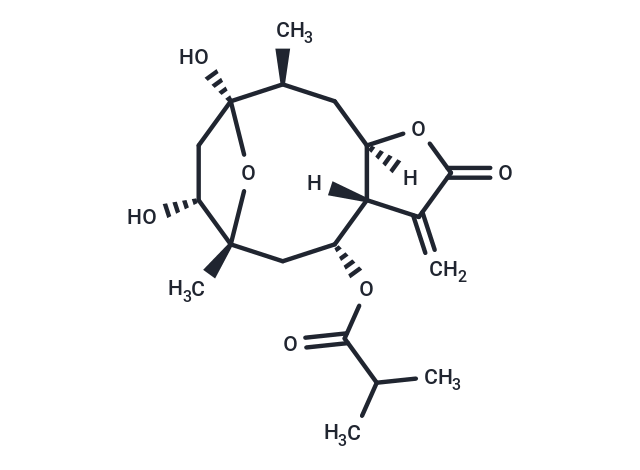 Your shopping cart is currently empty
Your shopping cart is currently empty

Tagitinin A is a naturally occurring sesquiterpene lactone compound that acts as a dual agonist of peroxisome proliferator-activated receptor α/γ (PPARα/PPARγ) and exerts antihyperglycemic and antihyperlipidemic effects in diabetes research.Tagitinin A is able to bind directly to the ligand-binding domain of PPARγ (IC50=55 μM), and also stimulates the PPAR Tagitinin A can directly bind to the PPARγ ligand binding domain (IC50=55 μM) and also stimulate the PPARα-dependent activation of the SULT2A1 gene promoter. As a phytotoxin, Tagitinin A significantly inhibited the growth of wheat germ sheath.

| Pack Size | Price | USA Warehouse | Global Warehouse | Quantity |
|---|---|---|---|---|
| 5 mg | $1,698 | Backorder | Backorder | |
| 1 mL x 10 mM (in DMSO) | $1,869 | Backorder | Backorder |
| Description | Tagitinin A is a naturally occurring sesquiterpene lactone compound that acts as a dual agonist of peroxisome proliferator-activated receptor α/γ (PPARα/PPARγ) and exerts antihyperglycemic and antihyperlipidemic effects in diabetes research.Tagitinin A is able to bind directly to the ligand-binding domain of PPARγ (IC50=55 μM), and also stimulates the PPAR Tagitinin A can directly bind to the PPARγ ligand binding domain (IC50=55 μM) and also stimulate the PPARα-dependent activation of the SULT2A1 gene promoter. As a phytotoxin, Tagitinin A significantly inhibited the growth of wheat germ sheath. |
| In vitro | Plants with pesticidal properties have been investigated for decades as alternatives to synthetics, but most progress has been shown in the laboratory. Consequently, research on pesticidal plants is failing to address gaps in our knowledge that constrain their uptake. Some of these gaps are their evaluation of their efficacy under field conditions, their economic viability and impact on beneficial organisms. METHODS AND RESULTS: Extracts made from four abundant weed species found in northern Tanzania, Tithonia diversifolia, Tephrosia vogelii, Vernonia amygdalina and Lippia javanica offered effective control of key pest species on common bean plants (Phaseolus vulgaris) that was comparable to the pyrethroid synthetic, Karate. The plant pesticide treatments had significantly lower effects on natural enemies (lady beetles and spiders). Plant pesticide treatments were more cost effective to use than the synthetic pesticide where the marginal rate of return for the synthetic was no different from the untreated control, around 4USD/ha, compared to a rate of return of around 5.50USD/ha for plant pesticide treatments. Chemical analysis confirmed the presence of known insecticidal compounds in water extracts of T. vogelii (the rotenoid deguelin) and T. diversifolia (the sesquiterpene lactone Tagitinin A). Sesquiterpene lactones and the saponin vernonioside C were also identified in organic extracts of V. amygdalina but only the saponin was recorded in water extracts which are similar to those used in the field trial. CONCLUSIONS:Pesticidal plants were better able to facilitate ecosystem services whilst effectively managing pests. The labour costs of collecting and processing abundant plants near farm land were less than the cost of purchasing synthetic pesticides. |
| Molecular Weight | 368.42 |
| Formula | C19H28O7 |
| Cas No. | 59979-61-2 |
| Smiles | O(C(C(C)C)=O)[C@H]1[C@@]2([C@@](C[C@H](C)[C@@]3(O)O[C@](C)(C1)[C@H](O)C3)(OC(=O)C2=C)[H])[H] |
| Relative Density. | no data available |
| Storage | Powder: -20°C for 3 years | In solvent: -80°C for 1 year | Shipping with blue ice/Shipping at ambient temperature. | |||||||||||||||||||||||||
| Solubility Information | DMSO: 16 mg/mL (43.43 mM), Sonication is recommended. | |||||||||||||||||||||||||
Solution Preparation Table | ||||||||||||||||||||||||||
DMSO
| ||||||||||||||||||||||||||
| Size | Quantity | Unit Price | Amount | Operation |
|---|

Copyright © 2015-2025 TargetMol Chemicals Inc. All Rights Reserved.